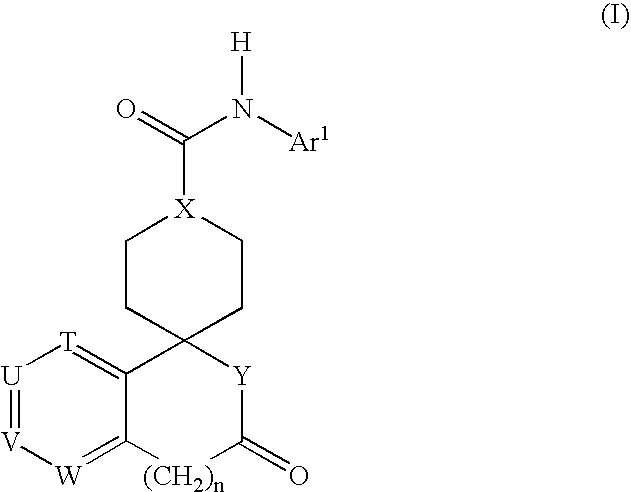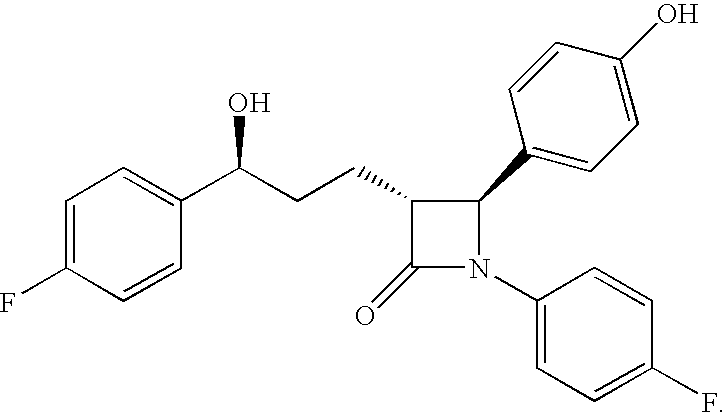Combination therapy for the treatment of dyslipidemia
a dyslipidemia and conjugation therapy technology, applied in the field of conjugation therapy for the treatment of dyslipidemia, can solve the problems of nicotinic acid as the raising agent of hdl, low concentration of hdl, drug with limited utility, etc., to improve the treatment and/or prevention of cardiac hypertrophy, reduce weight, treat, or prevent cardiac hypertrophy
- Summary
- Abstract
- Description
- Claims
- Application Information
AI Technical Summary
Benefits of technology
Problems solved by technology
Method used
Image
Examples
example 1
[0747] In vivo study for combination therapy with a NPY5 antagonist and an anti-dyslipidemic agent (effect on obesity / food intake and lipids)
[0748] DIO mice are treated simultaneously with an effective dose of a NPY5 antagonist and an effective dose of an anti-dyslipidemic agent.
Materials and Methods
[0749] Male C57BL / 6J mice (CLEA Japan Inc., 12-16 months old at the beginning of the drug administration) are used. Mice are given water and regular pellet chow (CE-2, CLEA Japan Inc.) ad libitum. They are kept in an animal room which is maintained at 23±2° C. temperature, 55±15% relative humidity and on a 12-hr light-dark cycle (7:00-19:00) during a quarantine and acclimatization period of 1 week. Before the start of drug administration, mice are fed a MHF diet (Oriental BioService Co., Tokyo, Japan) for about 9 to 10 months until the body weight gain reaches a plateau. After the body weight gain reaches a plateau, the diet is changed to a powder MHF diet. The powder MHF diet is giv...
example 2
[0751] Human study for combination therapy with a NPY5 antagonist and an anti-dyslipidemic agent (effect on obesity / food intake and lipids)
Materials and Methods
[0752] 800 people with a BMI≧30 are advised to diet and increase their physical activity. After a two-week placebo run-in period, which includes a standardized program of diet, physical activity, and lifestyle changes, the patients are randomized into 2 treatment groups: placebo and a second group is administered a combination of a NPY5 antagonist anti-obesity agent, such as for instance 100 mg / kg of compound A, and an anti-dyslipidemic agent, such as 20 mg of simvastatin. The NPY5 antagonist is given once per day, as previously determined to be effective. The anti-dyslipidemic agent is given once or more per day, as previously determined to be effective. Patients are treated for 6 months, body weights are measured biweekly, and appetite, hunger, satiety are measured weekly using standard questionnaires. At the end of the ...
example 3
[0754] Human study for combination therapy with a NPY5 antagonist and an anti-dyslipidemic agent (effect on Cardiac Hypertrophy and Left Ventricular Hypertrophy
Materials and Methods
[0755] 800 people with a BMI≧30 are advised to diet and increase their physical activity. After a two-week placebo run-in period, which includes a standardized program of diet, physical activity, and lifestyle changes, the patients are randomized into 4 treatment groups: placebo; an effective dose of a NPY5 antagonist, such as 1000 mg of Compound A; an effective dose of an anti-dyslipidemic agent such as simvastatin; and an effective dose of the NPY5 antagonist plus an effective dose of the anti-dyslipidemic agent. The NPY5 antagonist is given once or more per day, as previously determined to be effective. The anti-dyslipidemic agent is given once or more per day, as previously determined to be effective. Patients are treated for 6 months, body weights are measured biweekly, and appetite, hunger, satie...
PUM
| Property | Measurement | Unit |
|---|---|---|
| diastolic pressure | aaaaa | aaaaa |
| diastolic pressure | aaaaa | aaaaa |
| diastolic pressure | aaaaa | aaaaa |
Abstract
Description
Claims
Application Information
 Login to View More
Login to View More - R&D
- Intellectual Property
- Life Sciences
- Materials
- Tech Scout
- Unparalleled Data Quality
- Higher Quality Content
- 60% Fewer Hallucinations
Browse by: Latest US Patents, China's latest patents, Technical Efficacy Thesaurus, Application Domain, Technology Topic, Popular Technical Reports.
© 2025 PatSnap. All rights reserved.Legal|Privacy policy|Modern Slavery Act Transparency Statement|Sitemap|About US| Contact US: help@patsnap.com



